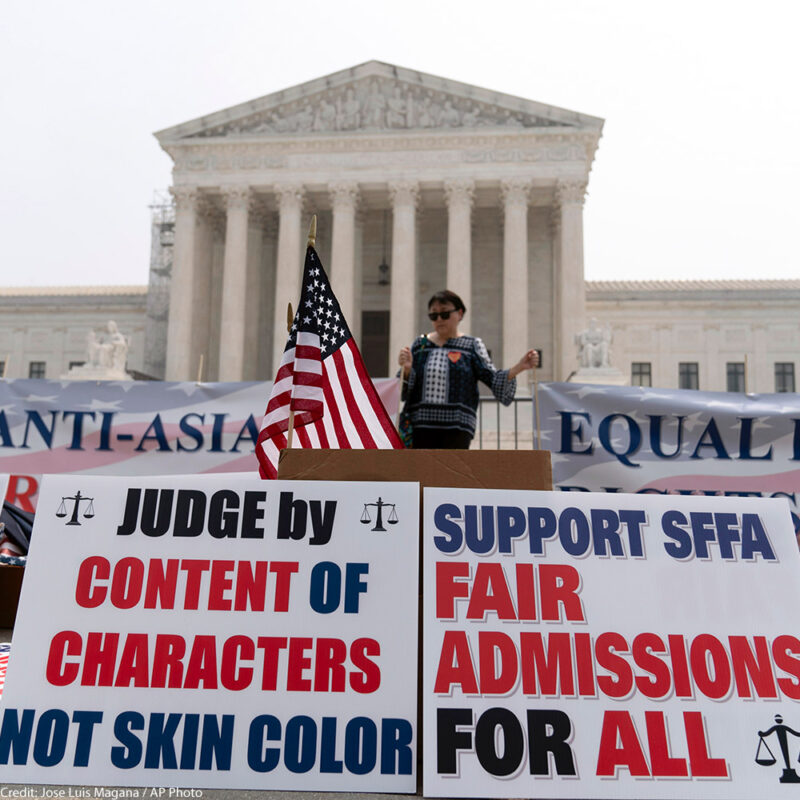With college application deadlines coming up this fall, stress levels are high for the class of 2024. However, for some students they may be even higher because of a recent Supreme Court decision that bans the use of affirmative action in college admissions, and the uncertainties about what this decision means.
Many of you may be wondering, “What is affirmative action anyway?” The Oxford Language Dictionary defines affirmative action in the context of the allocation of resources or employment as “the practice or policy of favoring individuals belonging to groups regarded as disadvantaged or subject to discrimination.” Affirmative action or race-conscious admissions practices allow universities to consider a student’s race as one factor in the admissions process in order to create a balanced and diverse campus. On June 29, 2023, the Supreme Court ruled by a vote of 6-3 to halt affirmative action in college and university admissions, in response to discrimination lawsuits brought by the Students For Fair Admissions (SFFA) against Harvard University and the University of North Carolina.
Opponents of the decision believe that it will have a wide range of negative impacts. For example, in October of 2022 the American Civil Liberties Union (ACLU) stated, “[It] will almost certainly mean a significant drop in the number of students of color being admitted to selective universities.”
The Center for American Progress (CAP) explains that this is because “Students of color have long faced systemic barriers in the American education system, including exclusion, segregation, underfunding, fewer resources, and lower familial wealth.” Affirmative action helps to combat this disadvantage and increase the representation of people of color in colleges. Without it, how the historical racism and disadvantages that many people of color face could affect their resume would not be taken into consideration.
In addition to the decision creating an equity issue, the CAP also argues that fewer students of color in universities will not only harm those directly affected. A diverse group of students is important to understand different perspectives and help bring people closer together. College counselor Nick Soodick explains that “study after study shows that working in a diverse environment is beneficial for students and employees.”
Diversity and equity are important values to the Pingree community; however, this decision prevents colleges and universities from explicitly considering race during the admission process. So what do Pingree seniors think about this Supreme Court decision?
“I didn’t really consider it before,” stated senior Ashley Mieses. However, she gave it a thought: “[the admissions process] is always a little bit unfair, a bit prejudiced, so when I’m in a minority, these laws make me nervous.”
Like Mieses, many students across the nation feel a sense of anxiety. “It will negatively impact a lot of people who depend on that support,” said senior Abby Torres. “Because my dad is Latinx and I am lower-middle class, I potentially could have received that help.”
Nick Soodick elaborates on the case: “[It} hinged on a misunderstanding on how affirmative action is used and unfortunately it has become the law of the land on how it is viewed. In reality, since ‘78, a student’s race was one component of many on a student’s application, but it was never the tipping point.”
While the Supreme Court decision has many detractors, others have welcomed the decision.The SFFA argued that “Harvard effectively uses a quota to cap the percentage of Asian-American admissions, and that the school engages in ‘racial balancing’ to maintain a certain racial breakdown on campus.” Now that SFFA has won its case, it’s possible that more Asian-Americans could be admitted to high profile universities.
Senior Kira Nielson feels as if this could benefit her. “There’s a lot of stereotypes surrounding Asians,” said Nielson. “I feel like before [with affirmative action] I would have a lower chance of getting in because [admissions officers might] think there are like ‘too many.’”
However, Nielson says that this issue is complicated and that Black or Hispanic/Latino people may be perceived differently and need their race acknowledged to show their whole identity.
However, even though affirmative action is officially gone, the good news is that students will have a chance to talk about who they are on their applications and to tell their story, whether that story is about race, social class, nationality, or ethnicity. Soodick says, “Colleges still have imperatives for creating a diverse body of students on campus. The methods of doing so have changed.”
Alexa Nova Vargas feels okay about this new process. “It will make people look at me as a whole rather than a statistic,” she said. She feels that her identity is an important part of her application, but she wants to express it in other ways than checking a box.
“Different backgrounds should play a role, not necessarily race precisely,” she says. “For instance, my experience as a Guatemalan immigrant has shaped who I am today, not necessarily my race. Some people do experience and are shaped by how certain people view their race. It is what they make of those experiences that shape them such as advocating, standing up, and being present for others that have gone and are going through the same thing. That work and experience is something that someone should be recognized for.”
So, while it is clear that Pingree students value equity and authenticity, it is hard to come to a conclusion about whether affirmative action is the best way to adhere to those values. There are a lot of mixed feelings about the process. It is impossible to know exactly what the consequences of this decision will be until this following year, and even then it may be difficult to tell how much this decision contributed to the outcome.








